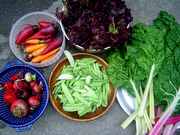

|
| Vegetable Varieties for Gardeners is a citizen science program
|
|
|
|
'Not specified' Spinach - New Zealand |
| |
| Sub-Category: |
None
|
| |
|
| Sub-Category 2: |
| | Description: |
Perennial. Sprawling plant with small fleshy green leaves. Heat resistant and withstands frost to low 20s. Seeds slow to germinate. Also known as Tetragonia.
|
| Days To Maturity: |
52-70
|
| Seed Sources: |
Seed Savers Exchange - updated in 2014
|
| |
| Rating Summary |
| |
Overall: (4.4 Stars)
Taste: (3.6 Stars)
Yield: (5.0 Stars)
Ease/Reliability: (4.6 Stars) |
| |
| Reviews |
| |
Login to share your Review of Not specified.
Number of Reviews: 5
KEY: O=Overall Rating, T=Taste, Y=Yield, E=Ease
Reviewed on 11/06/2008 by
gandle
- An experienced gardener
|
 Overall Overall
 Taste Taste
 Yield Yield
 Ease Ease
|
Dawson, Nebraska, United States
Frost Free Season: 143 - 163 days
Soil Texture: Loam
Garden Size: Medium - 400 square feet to 1,600 square feet
Sun Exposure: More than 8 hours per day
|
| Not especially fond of this by itself but in a half and half mixture of swiss chard and New Zealand spinach it is quite tasty. Easy to grow but soaking seeds overnight helps germination. |
| |
|
Reviewed on 05/04/2008 by
Slim Langer
- An intermediate gardener
|
 Overall Overall
 Taste Taste
 Yield Yield
 Ease Ease
|
Los Angeles, California, United States
Frost Free Season: More than 203 days
Soil Texture: Clay
Garden Size: Medium - 400 square feet to 1,600 square feet
Sun Exposure: 6 to 8 hours per day
|
| This is a weird and remarkable plant. It grows like ice plant, sprawling out with multiple vines from a central root. It is attractive and works as a ground cover. It has an unusual texture to the thick-lobed leaves that looks very much like vibrant green felt or velvet. It survives ok in my mild winter, expanding slightly, then goes crazy growing very rapidly with any touch of heat. As everyone says, it is slow to germinate from its oddly large and angular brown seeds. But it does break off and re-grow from the pieces, so you can cut off a stem and bury most of it to get a new plant somewhere else. It does have good nutrition, listed on the online calorie-counting sites: high in vitamins A and C + calcium and iron, though high in sodium. The taste is OK to good WHEN COOKED. Raw it has a metallic bitter aftertaste for me, that would otherwise make me wonder if it was truly edible. Once cut it lasts well in the fridge. |
| | | 1 of 1 gardener found this review helpful.
|
|
Reviewed on 12/31/2005 by
Perdidojim
- An experienced gardener
|
 Overall Overall
 Taste Taste
 Yield Yield
 Ease Ease
|
Escambia, Florida, United States
Frost Free Season: More than 203 days
Soil Texture: Sand
Garden Size: Medium - 400 square feet to 1,600 square feet
Sun Exposure: 6 to 8 hours per day
|
| Grows easily once it sprouts. It's best to soak the seed overnight before planting. Since you just pick some branches - not the whole plant - it continues to produce over the entire summer. It doesn't taste exactly like spinach, but it's close and very tasty. Around here it's about the only leafy vegetable that grows in mid-summer, so it's a very welcome addition to the garden. |
| | | 1 of 1 gardener found this review helpful.
|
|
Reviewed on 08/26/2005 by
Nancy B
- An intermediate gardener
|
 Overall Overall
 Taste Taste
 Yield Yield
 Ease Ease
|
Illinois, United States
Frost Free Season: 143 - 163 days
Soil Texture: Loam
Garden Size: Medium - 400 square feet to 1,600 square feet
Sun Exposure: 6 to 8 hours per day
|
| easy, easy, easy and stays all summer long. Gets a bit stringy in habit toward end of summer, but with pruning, new growth. Not quite the light "lettucy" taste profile of spinach, but prolific and darn good. |
| |
|
Reviewed on 06/15/2005 by
Kathy
- An experienced gardener
|
 Overall Overall
 Taste Taste
 Yield Yield
 Ease Ease
|
Michigan, United States
Frost Free Season: 123 - 143 days
Soil Texture: Loam
Garden Size: Large - More than 1,600 square feet (40' x 40')
Sun Exposure: More than 8 hours per day
|
| This salad plant is advertised as a good "spinach" for heat, but what should also be emphasized is that it is frost resistant -- it lasted through multiple light frosts and finally died with a hard one. Yes, it takes awhile to germinate -- make sure to soak the seeds overnight. However, to my great suprise, mine self-seeded pretty prolifically and is now growing up on its own. This gets around the germination issue since it basically decided when conditions were right on its own. |
| |
|
|
|
|
Vegetable Varieties for Gardeners is a citizen science program, © 2004-2024, All Rights Reserved
Cornell Garden Based Learning, Cornell University College of Agriculture & Life Sciences, Horticulture Section
|






 VVfG home
VVfG home
 Taste
Taste